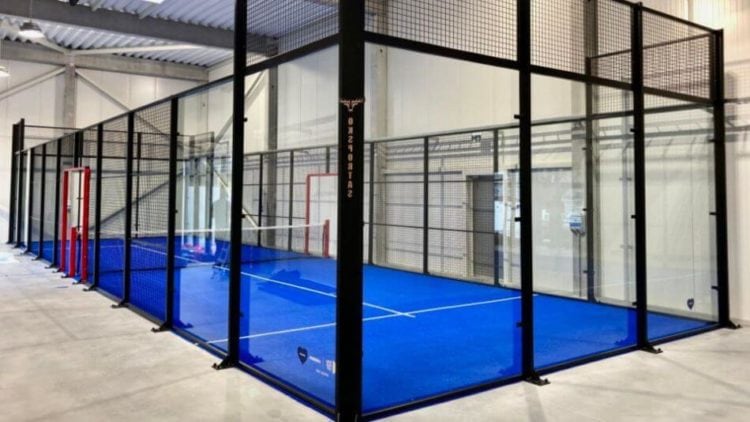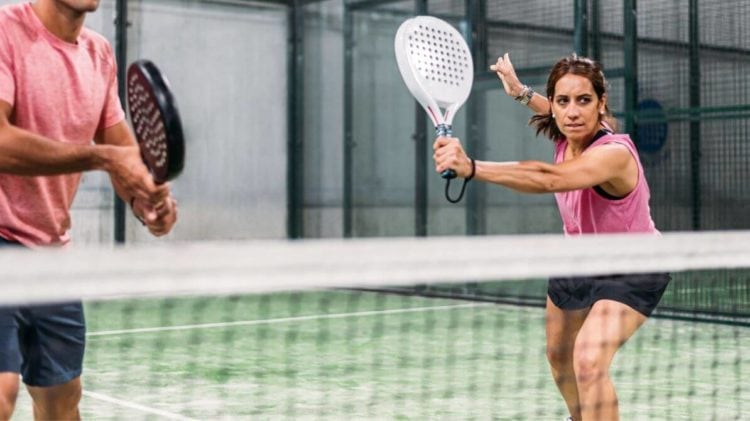
OBJECTIVE OF PADEL: Win more sets than the opposing team by hitting a ball over a net in a manner that doesn’t allow the opponents to legally return it.
NUMBER OF PLAYERS: 4 players
MATERIALS: Racquet, ball
TYPE OF GAME: Sport
AUDIENCE: 4+
OVERVIEW OF PADEL
Padel is a racquet sport that combines tennis and squash, as players hit a ball over a net, but the court is surrounded by four walls that can all be used during play. Although the sport is dominantly overshadowed by tennis in most countries, padel is still an incredibly popular sport worldwide, especially in Spanish-speaking countries.
The modern rendition of padel is said to have been created in 1969 by Mexican businessman Enrique Corcuera. Originally, Corcuera was trying to build an enclosed court for tennis in his home; however, he didn’t have enough space for a full-sized court. This lack of space resulted in him and a friend playing tennis on this small-sized court surrounded by walls, which eventually turned into the new padel rules.
Nowadays, padel is one of the fastest-growing sports in the entire world, especially in Latin America and Europe. Much of its success can be attributed to its simplicity—hit a ball back and forth over a net. Unlike some other racquet sports, padel features a ball that is designed to move slower than a normal tennis ball; this slow-moving ball, combined with the fact that players can’t hit the ball out of bounds, makes a strong case for why the sport is much easier to pick up than tennis. It even has a World Padel Tour, which brings even more new enjoyers of the sport.
SETUP

EQUIPMENT
- Racquet: A round padel racket is roughly 30% smaller than that used for tennis, measuring 18 inches in length. The padel racquet is made of carbon fiber and features a perforated racquet head. The small size of the racquet, in combination with the holes in the racquet’s head, is designed with mobility in mind.
- Ball: Padel balls are made of the same materials as tennis balls. However, these balls are roughly 8% smaller than their tennis counterpart and have an internal PSI of 11 compared to a tennis ball’s 14. This reduced air pressure allows the padel ball to move slower and bounce less. These are essentially a low compression tennis ball.
THE COURT
Padel courts measures 65 feet 7 inches long and 32 feet 8 inches wide or 20 by 10 meters, about a third smaller than a tennis court. These courts are surrounded by glass walls measuring roughly 10 feet in height along the long side of the court and 13 feet tall along the width side. A 35-inch-tall net lies directly in the middle of the court.
Unique to the sport of padel, each court features a doorway-like opening on both ends of the middle net. Players are allowed to run outside the court through this door to hit a ball that bounces outside of the court.
PLAYERS
Padel is solely a doubles-only sport. While there are a few singles courts around the world, a normal padel court is simply too large to be played with fewer than two players on each team.
GAMEPLAY

A padel match begins with one team serving the ball to the other. The team that receives the ball must hit it back over the net before it touches the opponent’s side of the court twice. Both teams continue this back-and-forth action until one team fails to return the ball legally.
Throughout the back-and-forth volleys, players aim to utilize their surrounding glass walls as much as possible to force their opponents into difficult or impossible situations.
SERVING RULES
When you play padel, one team holds serving privileges for the entirety of a set, with this privilege alternating after every set. The player serving the ball must do so from behind a designated service line from either the right or left side of the court (alternates after every point scored) by bouncing the ball on the ground and then hitting it at waist height or below (serves cannot be overhand).
Similar to tennis, a successful serve must land on the opposite diagonal half of the court in the correct service box. For example, a player serving the ball on the right side of the court must serve the ball so that it crosses the net and bounces on the left side of the court on the opponent’s side.
Like tennis, the server gets two chances to complete the serve legally. If the server misses both, this gives the opposing team a point due to a “double fault”.
SCORING AND COMPETITION FORMAT
Padel utilizes a scoring system and match structure identical to tennis. This means a team’s score increases from the same increments as tennis—0, 15, 30, 40, and game. Likewise, a team must win a game by two points. If this is not completed then a tie break is started continuing until a team reaches the two point lead needed.
Also akin to tennis, a team must win six “games” in order to win a set. As with the scoring seen in each individual game, a team must win by at least two games (6:4) in order to win the set point.
Padel matches are usually played in a best-of-three format, with the team that wins two sets being crowned the winner of the match.
RULES AND CONTEXT
- The team that receives a serve must wait to see if the ball bounces once on the ground before they can return it.
- When hitting the ball over the net, the is a foul unless it ball hits the ground before contacting any walls on the opponents court.
- Players are allowed to hit the ball against their own walls as long as the bounce takes it over the net.
THE WORLD’S TOP PADEL ATHLETES
As of 2023, Alejandro Galan and Juan Lebrón are considered to be the two best men’s padel athletes in the world. The two Spaniards joined forces in 2020 while Lebrón was already considered the top player in the world. Despite only having played together for less than three years, the pair has seen immense success, winning 14 tournaments in 2022 alone!
In women’s padel, two more Spaniard teammates top the leaderboards: Alejandra Salazar and Gemma Triay. The two teammates won 12 titles in 2022, ending the year on a five-tournament win streak!
END OF GAME
The first team to win two sets (in a best-of-three format) is deemed the winner of the padel tennis match.
- 30 GAMES TO PLAY OVER TEXT - April 22, 2024
- 20+ FREE PRINTABLE BABY SHOWER GAMES - April 16, 2024
- 20+ College Party Games for the Best Night Ever! - April 2, 2024